Board gaming these days truly comes in all shapes and flavors. From simple party titles that you could easily explain to a crowd of modestly inebriated people to brain-burning worker placement games and even solo affairs for when the crew can’t make it to a game night, there’s a ton of choice out there.
But what if you want an experience closer to traditional tabletop gaming, with a persistent yet ever-changing world and a campaign that sees your characters truly making an impact on the world around them? Try some legacy games, an increasingly popular genre in the community that has dominated board game charts in recent years.
So, what are some of the best legacy board games you can play in 2024? Read on to find out.
Top Legacy Board Games in 2024
- Pandemic Legacy: Season 1
- Frosthaven
- Clank! Legacy: Acquisitions Incorporated
- Ticket to Ride Legacy: Legends of the West
- Kinfire Chronicles: Night’s Fall
- Charterstone
- My City
- Betrayal Legacy
- The King’s Dilemma
- Sagrada Artisans
- Aeon’s End Legacy
- Zombie Kidz Evolution
How We Picked Our Favorites
With the surge in popularity of the genre in recent years, we are spoiled with more good legacy games than ever, and picking the very best among them is a daunting task. Legacy games are different from most other board games, so we had to come up with a list of criteria that address the unique mechanics of this genre.
First off, innovation in gameplay and mechanics is essential, as legacy games should provide a fresh and immersive experience with each session and have enough original ideas to differentiate them from the pack. Second, the depth and complexity of the evolving narrative are critical, as players should feel invested in the storyline and motivated to see it through to the end.
The permanence of player choices and their impact on the narrative should be visible as the game progresses, as this core aspect distinguishes legacy games from traditional board games. After all, many of these games feature campaigns that can only be played once, so players should truly feel like they have experienced a unique and unrepeatable adventure. Then there’s the artwork, the game board, and the other game components, which games like Gloomhaven have elevated to levels previously unseen in board gaming.
Lastly, the overall player experience, including cooperative or competitive dynamics, should be exceptional, fostering a sense of camaraderie, challenge, and excitement throughout the campaign.
A Closer Look at the Best Legacy Board Games in 2024
Now that we’ve introduced you to our top picks among legacy board games, it’s time to examine each one up close with concise reviews.
1. Pandemic Legacy: Season I
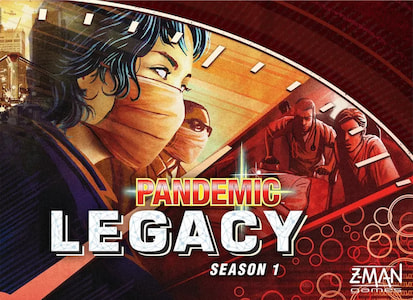
| Number of players: | 2 to 4 |
| Playing time: | 60 minutes |
| Age: | 13+ |
Pandemic Legacy was destined for success. Taking the beloved cooperative gameplay of the original Pandemic and splicing it together with excellent legacy mechanics created one of the most exciting and tense board games on the market.
The narrative-driven campaign thrusts players into a gripping, post-apocalyptic world where each decision has lasting consequences, and successes and failures in the early days of the disease outbreak can have dramatic effects on how the rest of the campaign plays out. It lasts between 12 and 24 sessions, pitting your team of disease experts against an ever-evolving worldwide pandemic of an unknown and deadly disease.
Players can take up to four actions on each of their turns. These allow them to move across the world, curing diseases, establishing research stations, swapping cards with other players, or discovering cures at previously created research stations. Each player takes the role of a specialist who comes with unique and helpful skills.
The game’s most novel and divisive feature is the one-off nature of the campaign. Not only will players discover new rules and components as they advance through the story, but they will also be required to permanently alter the game’s components, such as ripping up some of the playing cards.
While this means you won’t be able to replay the campaign after completing it once, it also ensures everyone has a unique story to tell after finishing it. And considering Pandemic Legacy has perhaps the best campaign of the board games we’ve played, it’s definitely an experience worth savoring.
Pros
- A brilliant mix of the traditional Pandemic formula with the new legacy mechanics
- Nail-biting and tense campaign
- Great value
Cons
- Can be very stressful
2. Frosthaven

| Number of players: | 1 to 4 |
| Playing time: | 30 – 120 minutes |
| Age: | 14+ |
If you thought Gloomhaven was great but could be even more ambitious and feature additional gameplay mechanics, boy have we got a game for you. Frosthaven is peak Isaac Childres: a monumental, complex, punishingly difficult, yet supremely designed legacy board game for one to four players.
Frosthaven builds on the success of one of the best cooperative legacy board games of all time, featuring a new 100-scenario campaign set in a remote outpost far from the capital of White Oak. Aside from the option to use all of Gloomhaven’s original characters and items, the new game features sixteen new heroes, twenty new enemies, over a hundred new pieces of gear, and three completely new races to choose from.
Familiar systems such as the tactical card-based combat and RPG character progression are bolstered with new and exciting mechanics such as settlement building, seasonal events, new out-of-combat events, and an expanded crafting system.
Post-scenario elements and outpost development are almost like a game in itself, and combined with the return of personal quests for each character ensure there is a ton of stuff to do outside of the game’s often combat-heavy scenarios.
Frosthaven is a natural evolution of one of the best legacy board games of all time, but it doesn’t reinvent the wheel. However, if you loved the original, this one will be a dream come true.
Pros
- Meaningful new post-scenario additions
- Engaging storyline
- Phenomenal production values
Cons
- Huge game that can be too complex for many players
3. Clank! Legacy: Acquisitions Incorporated
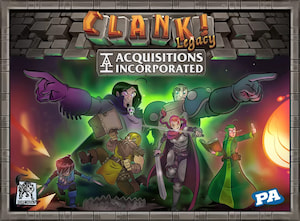
| Number of players: | 2 to 4 |
| Playing time: | 90 – 120 minutes |
| Age: | 13+ |
Clank! Legacy: Acquisitions Incorporated takes the beloved deck-building game and adds a campaign comparable to those found in the best legacy games on top of it. As fans of both the Clank! series and the wacky Acquisitions Incorporated team, we eagerly anticipated this fusion, and it definitely did not disappoint.
The game’s narrative-driven campaign is the standout feature, putting players in the roles of interns at Acquisitions Incorporated; a fledgling band of adventurers and treasure seekers determined to become the best franchise of the legendary adventuring company. To do this, they’ll have to brave all sorts of dangers through a 10+ session legacy campaign, mastering the nuances of the game’s excellent deck-building system featuring over 300 playable cards.
As with other top legacy tabletop games, Clank has plenty of surprises in store during its story campaign. Each adventure will develop in a unique way, with every game played affecting future games in sometimes unpredictable ways.
After finishing the campaign, players will have a uniquely tailored post-game adventure, which plays a lot like the original Clank! While a lot more competitive than the base game campaign, it also adds unique gaming value that not many other legacy games can offer.
If there’s one flaw we have to mention, it’s the slow turn order, which requires a lot of reading that compounds with the number of players at the table. Yet despite its sometimes slow pace, Clank! Legacy: Acquisitions Incorporated is a great campaign game, and a must-have for anyone who loves legacy-style games.
Pros
- Fun and engaging campaign
- Beautiful art style
- Plenty of content to experience after finishing the campaign
Cons
- Lots of reading and game-stoppage moments can make 4-player games very slow
5. Ticket to Ride Legacy: Legends of the West
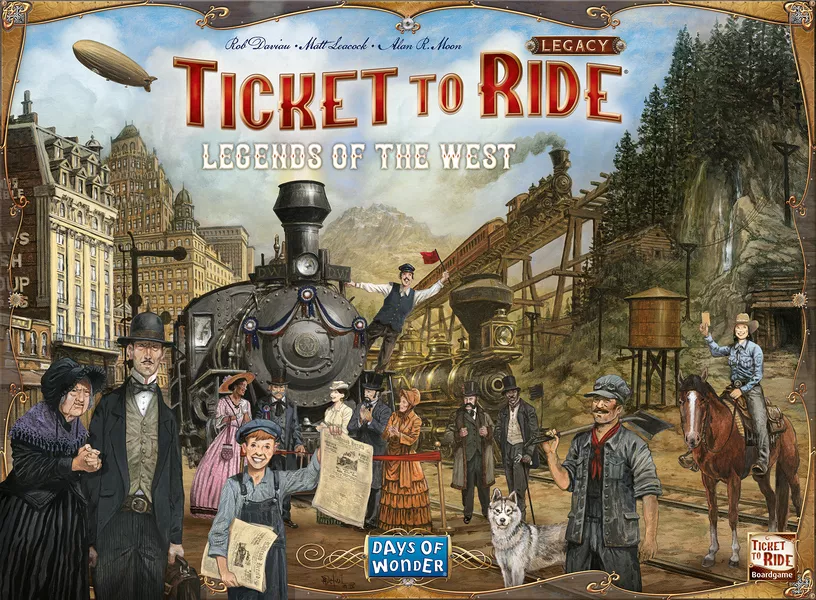
| Number of players: | 2 to 5 |
| Playing time: | 20 – 90 minutes |
| Age: | 10+ |
“Ticket to Ride Legacy: Legends of the West” transports players back to the 19th-century American frontier, this time in a legacy format. The new title, crafted by the minds behind the original Ticket to Ride and legacy game pioneers Rob Daviau and Matt Leacock, gives us an ambitious transformation of the familiar train-route-building gameplay into a multi-session evolving legacy campaign.
The game starts on a modest scale, using a small portion of the U.S. map that gradually expands as players progress through the campaign. Early gameplay will be familiar to veterans of Ticket to Ride, with players collecting and playing train cards to claim railway routes, which now slowly reveals larger portions of the map.
The legacy format also introduces new mechanics and elements unlocked through each game session, such as money management, event cards, and unique story-driven challenges. The board itself is a jigsaw puzzle, growing and changing as players unlock new regions and rail lines.
All of the new elements are introduced in a way that feels organic and doesn’t overwhelm the players with complex mechanics, making this one of the best games to introduce new players to the legacy genre. The production values are also top-notch, with lovely components and a well-organized game box, making for easy storage.
Overall, “Ticket to Ride Legacy: Legends of the West” is a fantastic addition to the genre and a great game for both legacy gamers and fans of the original title.
Pros
- A fantastic blend of old-school and new legacy elements
- Easy for beginners, complex enough for veterans
- Great production value
Cons
- Paper-thin story, but that’s probably not what you’re here for anyway
5. Kinfire Chronicles: Night’s Fall

| Number of players: | 1 to 4 |
| Playing time: | 45 – 60 minutes |
| Age: | 14+ |
Kinfire Chronicles is the first game by famous designer Kevin Wilson’s new team at Incredible Dream Studios. It’s a beautifully designed cooperative legacy game that can be played solo or with up to three friends. The game exudes professionalism, from its gorgeous artwork and clever box design to its simple-to-grasp yet challenging-to-master combat mechanics.
Up to four players will take up the mantle of the Seekers, future heroes of Atios, a world shrouded in magical darkness. Through a lengthy 21-scenario campaign, they will embark on an epic quest to save the realm from the encroaching arcane calamity, armed with only their wits, weapons, and magical “kinfire” lanterns.
In classic D&D fashion, this will involve not only battling all manner of fantasy nasties such as wyverns but also various NPC interactions and making tough choices with consequences in each mission. The game’s scenarios are typically split between town exploration, adventuring, and combat phases, all of which can be completed in less time than some combat scenarios in similar legacy games would take.
While the main story beats don’t change, each campaign will pan out slightly differently depending on which quests and scenarios the players discover and take on first and what characters they decide to play. The game can be reset completely, which combined with the six playable characters and multi-choice dilemmas throughout the adventure offers a ton of replay value.
Overall, Kinfire Chronicles is a fantastic and refreshing legacy board game, with beautiful art, interesting characters, challenging battles, and an intriguing world to explore. A future classic, to be sure.
6. Charterstone
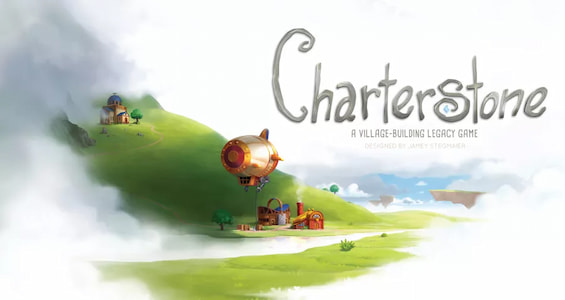
| Number of players: | 1 to 6 |
| Playing time: | 45 – 75 minutes |
| Age: | 14+ |
Charterstone was Stonemaier Games’ first shot at making a campaign-style game. This is a competitive worker placement game where you’ll be gathering all kinds of resources and trying to build the best village. The biggest selling point of Charterstone was that after the 12-part campaign was over, you could continue playing it forever and yet keep unlocking more new stuff. Stonemaier Games also sells recharge packs that let you replay the whole campaign or run two campaigns in parallel, as the game board is double-sided.
Similarly to other popular legacy games, Charterstone had you put down stickers and tear up cards. But, the stickers are various buildings you develop throughout the campaign, so every single choice you make is a permanent change of the game board. As you progress through the campaign and the game plays out, it becomes more complex, and various new mechanics are introduced. We won’t delve into spoilers, of course, we’ll just mention there are some cool surprises in that big white box we haven’t seen in any other legacy game.
Mechanically, playing Charterstone is very satisfying and you won’t get bored after playing it, even after numerous sessions beyond the 12 campaign scenarios. The game has a worker-bumping mechanic using different sizes (and types) of workers, alongside variable player powers depending on the chosen persona, and bonuses that stack up after each game, so you can develop a long-term plan. Truly, the only downside of Charterstone is that its story is a bit bland and nonconsequential, which makes your first couple of games a little slow.
Pros
- Wonderful components
- Very satisfying gameplay
- Plenty of surprises during the campaign
Cons
- Fairly mediocre story
7. My City
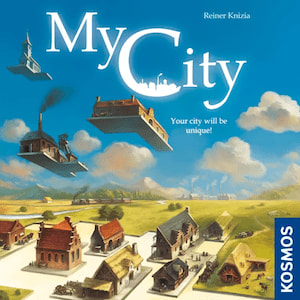
| Number of players: | 2 to 4 |
| Playing time: | 30 minutes |
| Age: | 10+ |
Are you a fan of city-building games? How about Tetris? Perhaps you are just looking for an affordable family-friendly title as a gateway to the legacy genre. My City checks all of these boxes, making it perhaps the best legacy board game on our list for introducing the hobby to inexperienced players.
At its core, My City is a tile-laying game where everyone at the table competes to build and develop the perfect city over several generations. Players place polyomino tiles on their individual boards, aiming to complete various objectives and score points. The strategic choices become more intricate as the game unfolds, keeping everyone engaged.
The game is divided into multiple episodes, each introducing new rules and challenges. This gradual complexity ensures that players can comfortably learn the game while experiencing a growing sense of accomplishment as they advance through episodes. Standard legacy mechanisms such as making physical changes to the board are also eased into, helping new players not feel overwhelmed.
The game also features optional stickers you can use to help struggling players or make life a bit more difficult for those in the lead, which is a nice catch-up mechanic that can help avoid one player dominating the game early and becoming impossible to defeat later. There is also a non-legacy, repeatable mode unlockable after you make a bit of progress in the main legacy campaign. My City’s only real downside is its bland and basic art style, but considering the game’s price, we can’t really fault it for that.
Pros
- One of the most affordable legacy games on the market
- Optional built-in catch-up and handicap mechanics
- Repeatable mode unlocked through legacy campaign progress
Cons
- Unremarkable art style
8. Betrayal Legacy
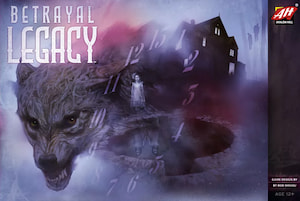
| Number of players: | 3 to 5 |
| Playing time: | 45 – 90 minutes |
| Age: | 12+ |
Betrayal at the House on the Hill is a board game favorite, famous for its immersive, spooky atmosphere and unpredictable gameplay. Betrayal Legacy takes the beloved classic to a new level by introducing smart legacy mechanics and an overarching narrative to the proceedings.
Players take on the roles of various families whose numerous generations keep returning to the haunted house trying to solve its deadly mysteries. The campaign consists of a prologue and 13 suspense-filled chapters, during which players will guide several generations of their families’ intrepid explorers, as they try to uncover the many dark secrets of the mansion before becoming its latest victims.
Aside from the legacy expansion, every core concept from the original game is here: the horror theme, the need to roll dice for most in-game actions, and yes, even the part where one player will betray the others, and start playing their own game against them.
That said, the game just feels better to play than the original ever did: the readable cards now feature some genuinely entertaining story snippets, there is a new and highly thematic book called The Bleak Journal, and the new heirloom items are an awesome addition that adds a real sense of building your family’s legacy as the campaign evolves.
Betrayal Legacy is a very good legacy game and a notable improvement over the original. Even if you weren’t a fan of the old game, give this one a spin – it improves on it in several meaningful ways, making for the definitive Betrayal experience in our opinion.
Pros
- A great mix of the original game with clever new legacy elements
- Very thematic legacy deck
- Heirloom items are an excellent addition
Cons
- Can be too luck-based, just like the original
9. The King’s Dilemma
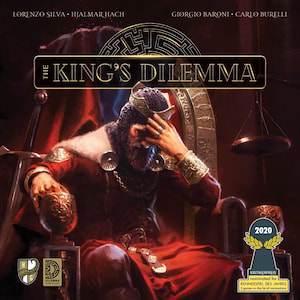
| Number of players: | 3 to 5 |
| Playing time: | 45 – 60 minutes |
| Age: | 14+ |
In the timeless words of Shakespeare, “Uneasy is the head that wears a crown.” Despite the name, though, King’s Dilemma won’t let you play king, even for a day. Instead, it puts players in the fancy shoes of various powerful families acting on the king’s behalf and leading the government of the Kingdom of Ankist.
The King’s Dilemma is a brilliant mix of legacy game mechanics (destroying components, placing stickers, permanently changing the game), an overarching story with branching narratives, and a cut-throat Game of Thrones-like battle between powerful noble houses. Players take the role of these houses, each having their hidden agendas and goals to pursue, sometimes matching the kingdom’s best interests but other times leading to famines, wars, or civil revolts.
The houses and their diverse goals are easily the game’s highlight: you’ll be able to choose everything from anarchistic technomancers to old-school conservative nobles, and even a literal cult, so the campaign definitely won’t be lacking flavor. As each family’s representative is but a part of the council, reaching any decision will be a tense affair requiring plenty of player interaction and bartering, which can be a real riot with the right gaming crew.
The game isn’t perfect, though: the rulebook can be a little confusing, and had us scratching our heads more than a few times during the campaign. While the card artwork is generally well done, the game board looks very basic and the game’s overall presentation could have used a bit more polish. Even so, if you’re a Game of Thrones fan, King’s Dilemma is definitely one of the top legacy board games you can play at the moment.
Pros
- Engaging gameplay that encourages player interaction
- The campaign features plenty of interesting and tough choices
- Each family feels unique
Cons
- Confusing rulebook
10. Sagrada Artisans
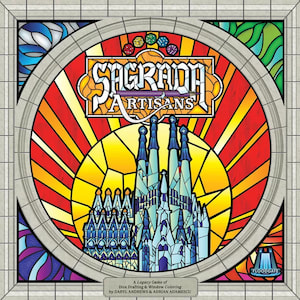
| Number of players: | 2 to 4 |
| Playing time: | 45 – 60 minutes |
| Age: | 13+ |
Sagrada by Adrian Adamescu and Daryl Andrews was one of the best board games of 2017, thanks in no small part to the beautiful artwork by Peter Wocken. This year’s game takes the best parts of the original and adds a permanent legacy campaign on top, though one admittedly light on story compared to most of the competition.
Players take on the role of famous glass-making families creating beautiful stained glass windows for a cathedral over several generations. The game plays over 10 scenarios, each played through 12 rounds, with players drafting dice and trying to fill out the empty spaces on the glass panel.
In addition to several rules regarding dice placement, further complications are introduced through special rules and events that occur in each round, giving players extra hurdles to overcome, but also additional chances to score points.
All players get a set of helpful tools for manipulating the dice, which can be used freely during each round, or even combined to get more favorable dice rolls. Finally, each player’s family also has a secret objective during the campaign, which they’ll be trying to work towards without anyone else at the table being any the wiser.
Sagrada was in our opinion one of the most beautiful board games on the market, and the legacy version continues this trend with gorgeous artwork adorning every page of the player’s fillable journals, each page of which will represent a new scenario and window to build. Our only complaint is the price: the relatively short campaign will set you back $75, which is a lot for a game with fairly inexpensive components and no miniatures.
Pros
- Easy to learn, tough to master
- Some clever and fun additions to the classic roll-and-write system
- Less beautiful than the original but still a gorgeous-looking game
Cons
- Way too expensive for what it is
11. Aeon’s End Legacy
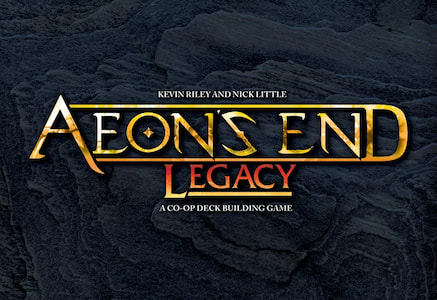
| Number of players: | 1 to 4 |
| Playing time: | 45 – 90 minutes |
| Age: | 13+ |
Gong Studios’ 2016 Aeon’s End was a major success for the studio and the legacy version of the game builds on that success by adding an interesting overarching story campaign and a strong sense of character progression on top of its already solid mechanics.
Set in the famous city of Gravehold, players take on the roles of apprentice breach mages, the last bastion against the encroaching horrors known as The Nameless. Through its seven-chapter campaign, they’ll grow into a formidable force by expanding their decks with ever-more-powerful cards in standard deck-building fashion.
What makes the game stand out is the unique breach mechanic, which gives the titular mage heroes their name. Breaches are basically a spell-queuing mechanic, allowing you to cast several spells on your turn. Aside from those, your deck will also house relics and gems, the former playable for immediate game-changing effects, while the latter is used to buy more powerful spell cards. The game also features no card reshuffling, so the order you play your cards is very important.
In addition to being a great cooperative experience, Aeon’s End Legacy is one of the best solo legacy board games we’ve played. As with the original, the artwork and miniatures are solid if not spectacular but the overall production value is excellent, and everything feels highly polished.
In conclusion, Aeon’s End Legacy may be not the best legacy or deck-building game you’ll ever play, but it’s a fantastic mix of both genres and a great game in its own right.
Pros
- Well-realized story and excellent solo mode
- Top-notch production values
- Great introduction to the world of Aeon’s End
Cons
- Can be on the easy side for deck-building veterans
12. Zombie Kidz Evolution

| Number of players: | 2 to 4 |
| Playing time: | 5 – 15 minutes |
| Age: | 7+ |
Dubbed the “first legacy game for kids,” Zombie Kidz Evolution is a fantastic entry point for getting children hooked on our favorite hobby just as much as you are.
While most board games (especially legacy ones) feature elaborate setups, hefty rulebooks, and extensive campaigns featuring dozens of scenarios that could each take up an entire gaming night, Zombie Kidz Evolution is designed so that even younger children (7+) could easily pick up and play it, making it the ultimate gateway board game.
It achieves this feat through a mix of extremely quick gaming sessions (5 to 15 minutes each) and a simple gameplay loop that gradually and gently introduces new mechanics as the campaign unfolds. Players take on the role of school kids faced with a sudden zombie invasion at school. The goal is, of course, to stop the zed tide, locking each of the four entryways to the school grounds while eliminating any undead standing in their way.
While it may not be one of the best legacy board games for 2 players, things really open up with three or four people at the table, and campaigns, though short, can get pretty hectic by the end. As missions are completed, new heroes, challenges, and powers become available, keeping things fresh while also increasing the difficulty, and ensuring the game stays interesting.
Zombie Kidz Evolution features lovely kid-friendly artwork and well-made components considering its highly affordable price tag. Our only complaint is that, as with most entry-level board games, too much in the game can rely on sheer luck.
Pros
- Fun and easy to learn
- Fantastic for kids and families
- Charming artwork
Cons
- Very basic gameplay that relies a lot on luck
Why Do We Love Legacy Board Games?
Although fairly young by board game standards, this genre quickly became one of the most popular ones in the hobby. Within weeks of release, games like Gloomhaven and Pandemic Legacy shot to the top of the BoardGameGeek charts and then managed to stay there for years, proving that the formula has a lasting appeal for board gamers across the globe. The Pandemic also heavily influenced the trend of converting traditional board games to the legacy format, even if that didn’t always work out the best (Ultimate Werewolf Legacy, anyone?)
So, what makes legacy games so special? Well, for starters, it’s the sense of adventure and permanent progression unique to your group, that changes the gameworld and campaign you’re playing with every new session. Although not all of them feature role-playing elements, these games are still the closest you can get to tabletop gaming and the sense of progression in the overarching narrative keeps the adventure fresh and exciting even after multiple gaming sessions.
Regardless of the theme, good legacy board games foster a unique camaraderie among players as they collectively shape the game’s destiny, forging shared memories and stories. The unique fusion of storytelling, strategy, and tangible progression taps into our innate desire for adventure and challenge.
Furthermore, the concept of making permanent changes to the game’s components as the campaign progresses, be it tearing up cards, placing stickers, or opening sealed envelopes, adds a level of commitment and emotional investment that traditional board games can’t replicate.
Finally, there’s the excellent value these games provide. Although typically more expensive than your average board game, their lengthy, narrative-focused campaigns will provide you with countless hours of quality gaming.
FAQ
-
What is a legacy-style game?
A legacy-style game is a board game that features a persistent campaign, meant to be played by the same players (and typically characters) over a series of gaming sessions. They are characterized by an overarching narrative-driven campaign and inspired by traditional tabletop RPG systems such as Dungeons & Dragons and Call of Cthulhu.
-
Are legacy games good?
Absolutely! Legacy board games are the best adaptations of traditional tabletop roleplaying in the board game format. Just like a good D&D campaign, though, these games require serious time and commitment, so make sure you’re ready for that.
-
What was the first legacy game?
The genre as we know it was popularized by the legacy version of an iconic classic board game. Risk: Legacy was a 2011 reimagining of the popular title by designers Rob Daviau and Chris Dupuis. It introduced the concept of a persistent campaign with an ever-evolving world, while also improving on some long-standing issues players had with the original.
-
Which Pandemic Legacy is best?
All three currently released Pandemic Legacy seasons are highly popular with players and rated as some of the best legacy board games on the market. That said, Season I is by far the best-received one, currently sitting at the #1 spot for thematic games, and #2 in the overall and strategy categories.

Ivan Stevanovic
Ivan is our wordsmith extraordinaire and a passionate board gamer and RPG veteran. A gaming nerd since an early age, he got started with computer gaming back in the ZX Spectrum days (yeah, he is that old) and with board gaming while playing Monopoly as a kid.
Boar Gamer may receive revenue from affiliate and advertising partnerships for sharing this content and from purchases through links.
